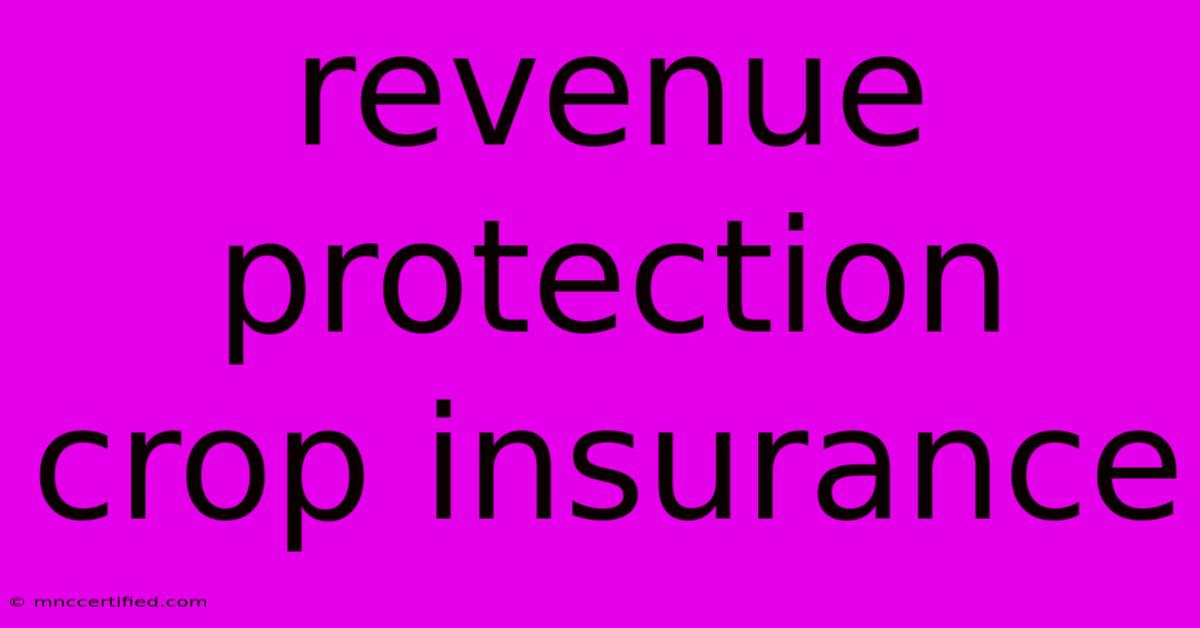Revenue Protection Crop Insurance

Table of Contents
Revenue Protection Crop Insurance: A Comprehensive Guide for Farmers
Revenue Protection (RP) crop insurance is a vital tool for farmers looking to mitigate the risks associated with unpredictable weather, market fluctuations, and other unforeseen events. Unlike traditional yield-based insurance, RP protects not only your yield but also your revenue. This means you're covered against both low yields and low prices. Understanding how RP works is crucial for making informed decisions about protecting your farm's financial health.
Understanding the Mechanics of Revenue Protection
RP insurance calculates your coverage based on your projected revenue, which is determined by your:
- Projected yield: This is based on your farm's historical yields, adjusted for trends and expected growing conditions.
- Price elections: You choose a price per unit (e.g., bushel of corn, pound of cotton) at the time of policy purchase. This price is often based on the futures market, providing a baseline for your revenue calculation.
How does it work in the event of a loss?
If your actual revenue (actual yield x harvest price) falls below your guaranteed revenue (projected yield x price election), the insurance policy will cover the difference. This provides a safety net against both low yields and price drops, offering comprehensive protection.
Key Benefits of Revenue Protection Crop Insurance
- Price protection: This is a major advantage over yield-based policies. RP protects you against price volatility, a significant risk in the agricultural market.
- Comprehensive coverage: It safeguards against various perils, including drought, flood, excessive heat, hail, and other factors that can impact both yield and price.
- Financial stability: By mitigating revenue losses, RP insurance provides farmers with crucial financial stability, enabling them to plan for future investments and operations.
- Reduced risk: The safety net offered by RP allows farmers to take calculated risks, such as adopting new technologies or expanding their operations.
- Access to credit: Lenders often view RP insurance favorably, potentially improving access to credit and more favorable loan terms.
Choosing the Right Revenue Protection Plan
Selecting the appropriate RP plan involves careful consideration of several factors:
- Coverage level: You choose the percentage of your projected revenue you want insured (e.g., 75%, 80%, 85%). Higher coverage levels mean greater protection but also higher premiums.
- Price elections: Strategically selecting your price election requires analyzing market trends and forecasting potential price fluctuations. Consulting with an insurance agent is highly recommended.
- Insurance provider: Different providers may offer varying coverage options, premium rates, and service levels. Compare offerings carefully to find the best fit for your needs.
- Your individual farm circumstances: Factors such as historical yields, soil type, and planting practices should all be considered when selecting a plan.
Working with Your Insurance Agent
Your insurance agent is your crucial partner in navigating the complexities of RP insurance. They can help you:
- Determine your appropriate coverage level.
- Analyze market conditions and select suitable price elections.
- Understand the policy's terms and conditions.
- File a claim if a loss occurs.
Revenue Protection vs. Yield Protection: Key Differences
While both Revenue Protection and Yield Protection (YP) offer crop insurance, their approaches differ significantly. YP only covers losses due to low yields, leaving farmers vulnerable to price drops. RP provides far superior protection by covering both yield and price risks, making it a more comprehensive and financially sound choice for most farmers.
Frequently Asked Questions (FAQs)
Q: How much does Revenue Protection insurance cost? A: Premiums vary based on factors like coverage level, chosen price election, crop type, and location.
Q: What are the eligibility requirements? A: Eligibility requirements vary depending on the insurance provider and the specific crop.
Q: When should I purchase my policy? A: The exact timeframe depends on your location and crop, but generally, it's essential to purchase your policy well before the planting season begins.
Q: What happens if my harvest is lost due to a covered peril? A: If your actual revenue falls below your guaranteed revenue due to a covered peril, you will receive an indemnity payment to compensate for your loss.
By carefully considering the aspects outlined above and working closely with your insurance agent, you can effectively utilize Revenue Protection crop insurance to safeguard your farm's financial future and navigate the inherent uncertainties of agriculture. Remember, proactive risk management is key to long-term success in farming.

Thank you for visiting our website wich cover about Revenue Protection Crop Insurance. We hope the information provided has been useful to you. Feel free to contact us if you have any questions or need further assistance. See you next time and dont miss to bookmark.
Featured Posts
-
Seahawks 49ers 2024 Live Stream Guide
Nov 18, 2024
-
Celebrity Lineup Fans Notice Errors
Nov 18, 2024
-
Record Rainfall Flood Watch Until Monday
Nov 18, 2024
-
Barry Forms I M A Celeb Friendship
Nov 18, 2024
-
Falcons Broncos Matchup Players To Track
Nov 18, 2024